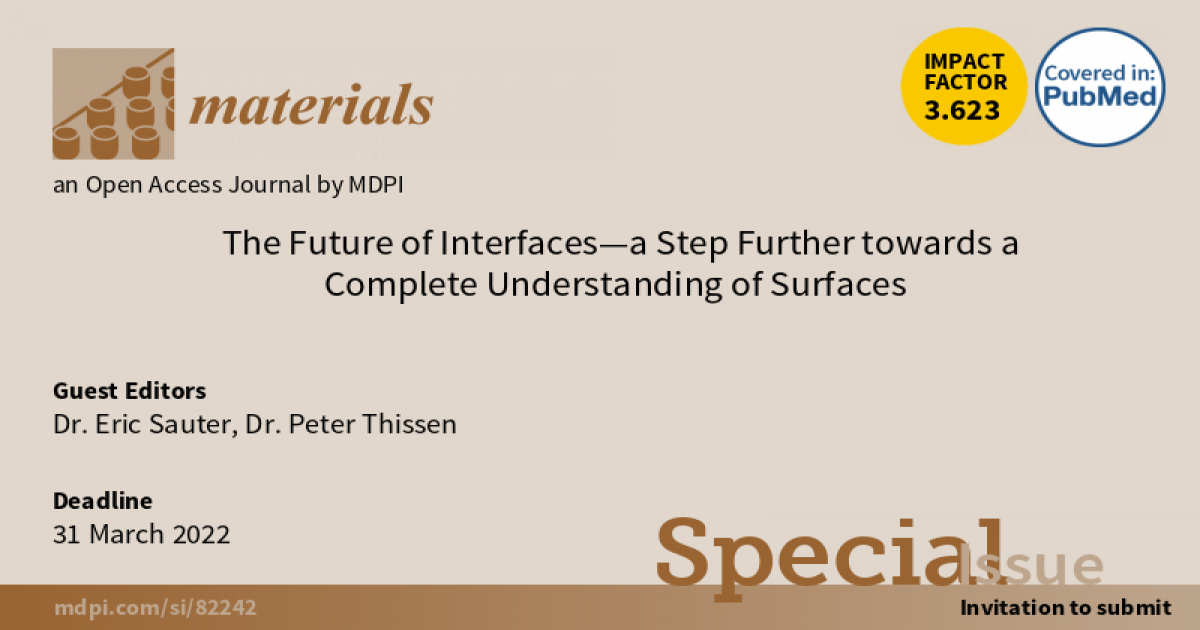The Future of Interfaces—a Step Further towards a Complete Understanding of Surfaces
A special issue of Materials (ISSN 1996-1944). This special issue belongs to the section "Thin Films and Interfaces".
Deadline for manuscript submissions: closed (31 March 2022) | Viewed by 6284

Special Issue Editors
Interests: surface science; surface spectroscopy; thin films, metallic and oxidic surfaces; novel interfaces; interface engineering; nanomaterials
Special Issue Information
Dear Colleagues,
Surfaces and interfaces of many types play a critical role in modern technologies associated with catalysis, electronics, energy conversion and storage, as well as medicine and health.
The goal of modern surface chemistry is to improve the understanding of the mechanisms and reactions at interfaces down to a molecular level. This in-depth understanding can be achieved by either controlling surface properties using surface-engineering techniques or by revealing the secrets of known surfaces with new or innovative analysis techniques.
The field of surface-engineering has rapidly expanded in the last few decades as the demand for enhanced materials has drastically increased. The thirst for materials displaying favorable properties (catalytic activity, optical transparency, toughness, conductivity, etc.) as well as their interactions with their surroundings in a specific manner has driven this expansion. In addition, the constant need for downscaling makes advances in surface-engineering even more important.
Over the past few decades, various surface-science techniques have been developed, and a vast amount of knowledge about surface chemistry has been accumulated. As the features being analyzed constantly decrease in size, the bulk analysis of small objects and surface analysis will be indistinguishable in the future, and any tool that can provide detailed information (compositional or structural) at the smallest spatial scale will be of interest.
The aim of this Special Issue is to present novel and interesting results for a better grasp of interface chemistry. The topics of interest include but are not limited to:
- Surface materials and surface-engineering;
- Interfaces and their applications;
- Spectroscopic insights in surface chemistry.
It is my pleasure to invite you to submit a manuscript for this Special Issue. Full papers, communications, and reviews are all welcome.
Dr. Eric Sauter
Dr. Peter Thissen
Guest Editors
Manuscript Submission Information
Manuscripts should be submitted online at www.mdpi.com by registering and logging in to this website. Once you are registered, click here to go to the submission form. Manuscripts can be submitted until the deadline. All submissions that pass pre-check are peer-reviewed. Accepted papers will be published continuously in the journal (as soon as accepted) and will be listed together on the special issue website. Research articles, review articles as well as short communications are invited. For planned papers, a title and short abstract (about 250 words) can be sent to the Editorial Office for assessment.
Submitted manuscripts should not have been published previously, nor be under consideration for publication elsewhere (except conference proceedings papers). All manuscripts are thoroughly refereed through a single-blind peer-review process. A guide for authors and other relevant information for submission of manuscripts is available on the Instructions for Authors page. Materials is an international peer-reviewed open access semimonthly journal published by MDPI.
Please visit the Instructions for Authors page before submitting a manuscript. The Article Processing Charge (APC) for publication in this open access journal is 2600 CHF (Swiss Francs). Submitted papers should be well formatted and use good English. Authors may use MDPI's English editing service prior to publication or during author revisions.
Keywords
- surface materials
- interface engineering
- thin films
- nanomaterials
- lithography
- surface spectroscopy
- novel interface applications
Benefits of Publishing in a Special Issue
- Ease of navigation: Grouping papers by topic helps scholars navigate broad scope journals more efficiently.
- Greater discoverability: Special Issues support the reach and impact of scientific research. Articles in Special Issues are more discoverable and cited more frequently.
- Expansion of research network: Special Issues facilitate connections among authors, fostering scientific collaborations.
- External promotion: Articles in Special Issues are often promoted through the journal's social media, increasing their visibility.
- Reprint: MDPI Books provides the opportunity to republish successful Special Issues in book format, both online and in print.
Further information on MDPI's Special Issue policies can be found here.







